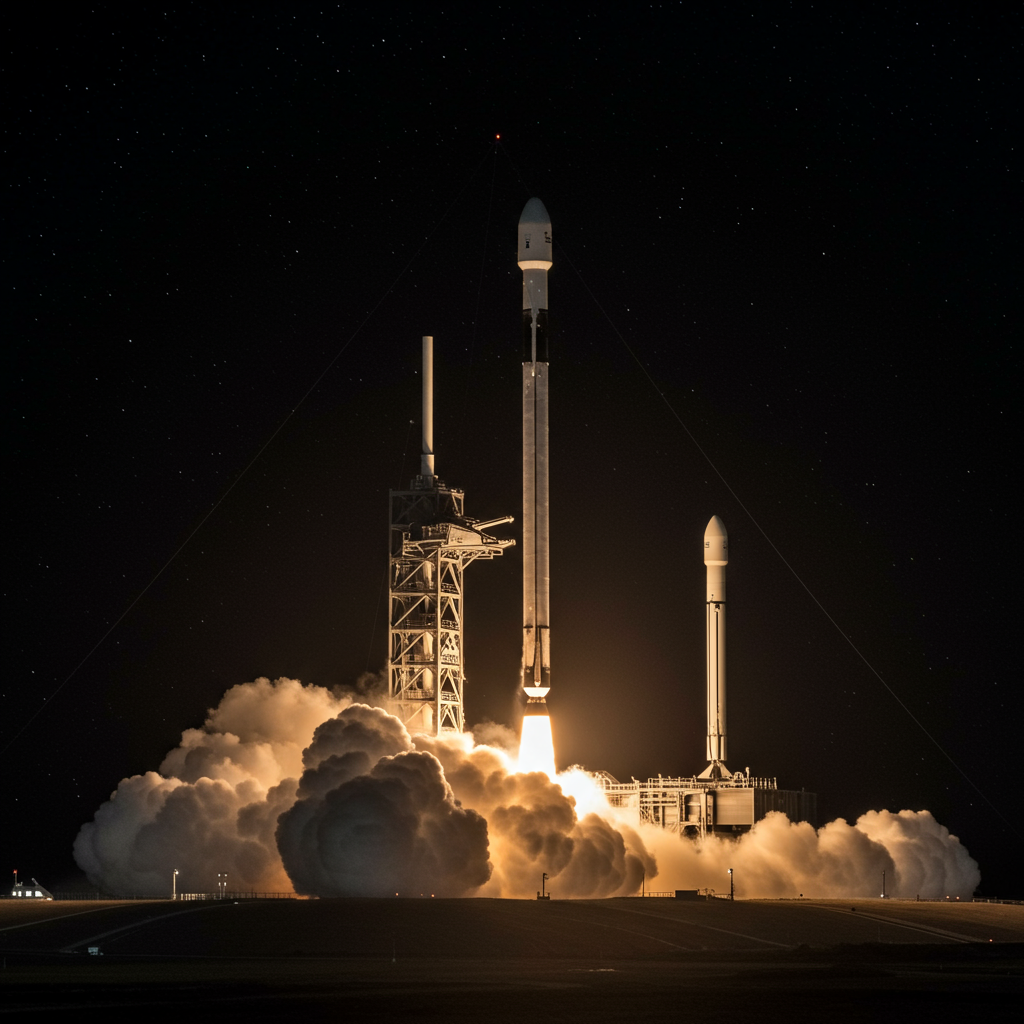SpaceX’s Falcon 9 rocket continues to redefine the possibilities of spaceflight. Recent groundbreaking milestones are silencing long-standing industry skepticism. These achievements underscore the profound value of the company’s pioneering first-stage reuse technology. Once dismissed as impractical, this “dumb” approach has emerged as the most intelligent and economically viable path forward. The Falcon 9’s consistent performance is not just a testament to engineering prowess; it marks a pivotal shift in the global aerospace landscape.
The Unfolding Success of Falcon 9 Reusability
In a week often dominated by the ambitious Starship program, SpaceX’s reliable workhorse, the Falcon 9, quietly reached significant new heights. These impressive feats occurred during routine launches of Starlink satellites. Despite their low-key nature, these milestones vividly illustrate the power of SpaceX Falcon 9 reuse. They cement its position as a transformative force in the space industry.
The company’s dedication to recoverable rockets has transformed launch economics. It has also set new operational benchmarks. SpaceX has proven that bringing rockets back for multiple missions is not just feasible but incredibly efficient. This commitment has reshaped global access to space.
A Record-Setting Workhorse Takes Flight
The first notable achievement came on Wednesday morning. The Starlink 10-56 mission launched from Cape Canaveral, Florida. Its first stage, Booster 1096, completed its second successful flight. It then performed a flawless landing on the “Just Read the Instructions” drone ship. This landing marked SpaceX’s remarkable 400th successful drone ship recovery. It is a testament to their operational mastery.
Less than 24 hours later, another Falcon 9 rocket launched the Starlink 10-11 mission. This launch originated from a nearby pad at Kennedy Space Center. Booster 1067, a truly special vehicle, returned and landed expertly on the “A Shortfall of Gravitas” drone ship. This particular booster achieved an unprecedented milestone. It completed its 30th flight. This is a record for any Falcon 9 first stage. Since its debut in June 2021, Booster 1067 has supported a diverse array of critical missions. These include delivering two Crew Dragon vehicles to the International Space Station and deploying Galileo satellites for the European Union. These repeated successes highlight the robustness and reliability of Falcon 9 reusability.
A Decade of Daring Innovation: Pioneering Rocket Recovery
These recent achievements are the culmination of a decade of relentless effort. SpaceX began its journey to master first-stage reuse in September 2013. That month, the company executed a controlled entry of the Falcon 9’s first stage. This pioneering test, using version 1.1 of the vehicle, proved the concept of supersonic retropropulsion. Until then, this idea was largely theoretical.
Supersonic retropropulsion involves igniting a rocket’s engines while it travels at speeds exceeding the speed of sound. This occurs in the upper atmosphere. External temperatures during this phase can soar above 1,000 degrees Fahrenheit. The immense blunt force of reentry presented significant engineering hurdles. According to Tom Mueller, SpaceX’s chief of propulsion at the time, the outer ring engines often wanted to splay out. Success on that initial attempt seemed improbable.
From Ocean Splashdown to Precision Landings
Mueller recalled watching that momentous launch from Vandenberg Space Force Base. A camera on Elon Musk’s private jet tracked the rocket’s reentry. Amazingly, the first stage made it down intact. “I remember watching the live video and seeing the light of the engine on the ocean,” Mueller recounted. “And holy shit, it was there. The rocket came down, landed in the ocean, and blew up. That was unreal. It worked the first time. I was like, get the barge ready. Get the landing legs ready. This shit works.”
This initial, albeit crude, success validated the core concept. It sparked further intensive tinkering and experimentation. By December 2015, SpaceX celebrated its first land landing along the Florida coast. The first successful drone ship landing followed in April 2016. Less than a year later, in March 2017, SpaceX re-flew a Falcon 9 stage for the very first time. Each step built towards the incredible booster landing capabilities seen today.
Silencing the Skeptics: SpaceX’s “Dumb” Approach Proves Genius
SpaceX’s persistent pursuit of full first-stage reuse was met with considerable skepticism. Many industry veterans and competing space agencies doubted its practicality. In the mid-2010s, major players like the European Space Agency and the Japanese Space Agency were developing their next-generation rockets. Europe’s Ariane 6 and Japan’s H3 both opted for traditional, expendable rocket designs. They chose not to pursue reuse technology.
This strategic choice has left them significantly behind. Both agencies are now roughly a decade behind SpaceX in advanced launch technology. The gap in aerospace innovation continues to widen. If SpaceX’s larger, fully reusable Starship rocket proves successful, this lead could become insurmountable. The decision to embrace reusability versus expendability has fundamentally altered the competitive landscape.
ULA’s “SMART” vs. SpaceX’s Proven Model
United Launch Alliance (ULA), historically a primary competitor to SpaceX in the United States, was particularly dismissive. A decade ago, ULA engineers published papers and conducted studies. These analyses argued that SpaceX’s booster flyback method was impractical and economically unviable. Around 2015, ULA began promoting its own “Sensible Modular Autonomous Return Technology” (SMART) concept. This plan for their Vulcan rocket involved recovering only the engine section. The implicit message behind the “SMART” acronym was clear: SpaceX’s full booster recovery approach was, in their view, “dumb.”
ULA’s analysis in 2015 suggested their SMART plan would yield cost savings by just the second launch. Conversely, they claimed SpaceX’s full reuse method would require 10 flights to achieve similar economic benefits. Those engineers likely never imagined the future. A decade later, SpaceX Falcon 9 reuse has achieved 30 flights for a single booster. SpaceX now boasts an annual launch cadence that approaches ULA’s entire 20-year operational history. Meanwhile, ULA’s SMART concept remains a theoretical design, never fully implemented.
The Economic and Strategic Impact of Reusability
The sheer number of reuses, particularly Booster 1067’s 30 flights, highlights enormous economic advantages. Each reflight dramatically reduces the cost per launch. This translates into more affordable access to space for governments and commercial entities. SpaceX’s ability to achieve such a rapid and high launch cadence has also given it a decisive advantage in the burgeoning satellite internet market. The Starlink constellation, for instance, relies entirely on this rapid and cost-effective deployment capability.
This isn’t just about saving money. It’s about a complete paradigm shift. SpaceX has demonstrated that rapid, routine, and affordable access to orbit is achievable. This changes everything from scientific research to national security. The company’s innovative spirit and willingness to challenge convention have set a new standard for the entire space industry. Falcon 9 reusability has democratized access to space, making ambitious missions more attainable than ever before.
A New Era for Space Access
The success of the Falcon 9’s reuse program validates a core tenet of SpaceX’s philosophy. It proves that aggressive innovation, combined with iterative development, can overcome seemingly impossible engineering challenges. This shift has not only driven down launch costs but has also accelerated the pace of space exploration. It has enabled a new era of satellite mega-constellations. This era demands high-cadence, low-cost launches. This groundwork is also crucial for future deep-space missions and the ultimate goal of making humanity a multi-planetary species.
The lessons learned from perfecting Falcon 9’s return-to-launch-site and drone ship landings directly feed into the development of Starship. This larger, fully reusable system aims to make space travel even more routine and affordable. The journey from a speculative concept to a dominant, proven technology is a powerful narrative of vision, persistence, and engineering brilliance. The SpaceX Falcon 9 reuse story is a testament to the power of challenging the status quo.
Frequently Asked Questions
What specific milestones has SpaceX’s Falcon 9 achieved recently regarding reusability?
SpaceX’s Falcon 9 recently achieved two significant milestones. One booster completed the company’s 400th successful drone ship landing. This occurred during the Starlink 10-56 mission with Booster 1096 making its second flight. Separately, Booster 1067 made its record-setting 30th flight during the Starlink 10-11 mission. This is the first time any Falcon 9 first stage has reached this level of experience, demonstrating unparalleled Falcon 9 reusability.
How did SpaceX overcome initial skepticism and technical challenges to perfect its reusable rocket technology?
SpaceX faced significant skepticism from the aerospace industry, but persisted through a decade of development. They proved the theoretical concept of supersonic retropropulsion in 2013, despite extreme heat and forces. Through iterative development, they progressed from controlled ocean splashdowns to precision land landings by 2015 and drone ship landings by 2016. This continuous refinement, along with a high-risk tolerance, allowed them to perfect booster landing techniques and operational processes.
What are the key economic advantages of SpaceX’s full first-stage reuse approach compared to traditional expendable rockets?
SpaceX’s full first-stage reuse approach offers substantial economic advantages. It dramatically lowers the cost per launch by eliminating the need to build a new first stage for every mission. This reduction in cost enables a much higher launch cadence, as seen with SpaceX’s annual launches rivaling competitors’ two-decade totals. This efficiency has allowed SpaceX to dominate commercial satellite deployment, particularly for its Starlink constellation, demonstrating the profound value of SpaceX Falcon 9 reuse.
Conclusion: The Sky’s No Longer the Limit
SpaceX’s Falcon 9 has not merely achieved engineering feats; it has fundamentally altered the trajectory of human spaceflight. Its journey from a ridiculed “dumb” idea to a proven, dominant technology showcases the power of visionary thinking and relentless execution. The recent milestones, including the 400th drone landing and Booster 1067’s 30th flight, are powerful symbols of this triumph.
The economic efficiencies and accelerated launch capabilities unlocked by SpaceX Falcon 9 reuse have not only solidified the company’s market leadership but also made space more accessible and affordable than ever before. As the aerospace industry looks to the future, SpaceX’s legacy of innovation will continue to inspire. It reinforces the idea that true progress often comes from challenging established norms and daring to pursue what others deem impossible.



